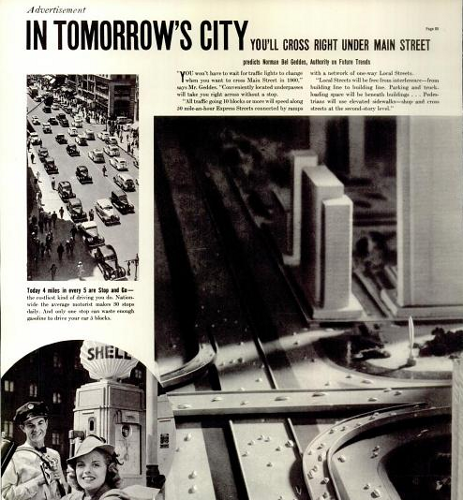
Image Credit: Shell
The future of Norman Bel Geddes' Futurama is optimistic. Clean architecture and efficient technology aid people as they move through the business of their day. As promised in a series of 1937 Shell advertisements in Life magazine using the words of Bel Geddes, the city of tomorrow will alleviate many commuting frustrations. Until that city emerges, however, the ads offer Shell gasoline as a way to save money and reduce wear and tear on car engines while stuck in stop-and-go traffic. This use of a hopeful future contrasts with the darker tomorrows that lurk behind many of today's petroleum advertisements, drawing attention to the double-edged sword of appeals to the future.
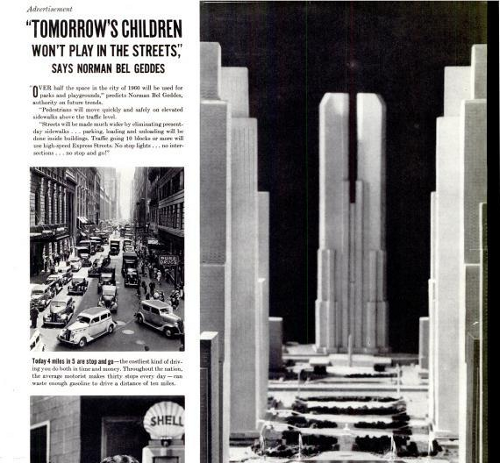
Image Credit: Shell
In the 1937 ads, the Shell Corporation promotes its product as a stopgap to deal with the failings of the present until the the arrival of a better future. The first ad quotes Bel Geddes promising that by 1960 stoplights will be a thing of the past, as cars use underpasses and express streets to reach their destinations. The second ad has Bel Geddes reassure us that "children won't play in the streets" and pedestrians will not impede the flow of traffic. A third ad shown below places Bel Geddes in profile next to a quote about pedestrians, express and local traffic all having their own paths.
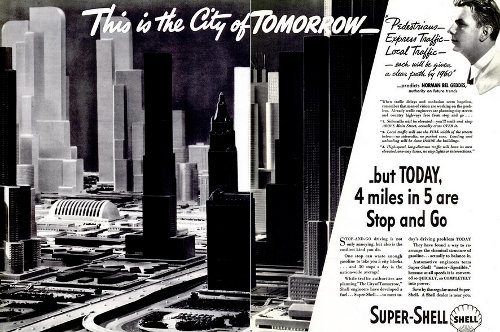
Image Credit: Shell
Two ads contrast photographs of overcrowded and traffic-choked streets of the late 1930s with the clean, efficient cityscape sketches and models of Bel Geddes. In two of the ads, a third visual bridges the present and future: photos of smiling, happy motorists posed in their cars with Shell gasoline pumps in the background. The ad text spells out the argument: "The regular use of Super-Shell will cut the cost of your stop and go. There's a Shell dealer near you."
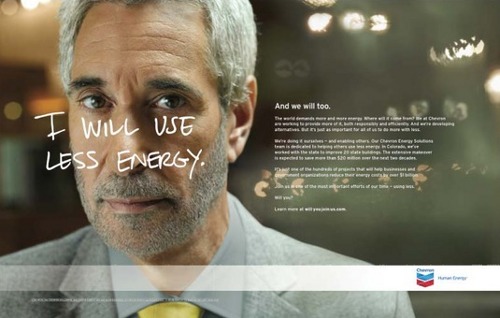
Image Credit: Chevron
That such hassle-free commutes failed to materialize is personally a source of disappointment (especially as I dodge vehicular traffic while walking to the bus stop each morning), but the failure of the future to live up to our highest hopes isn't terribly surprising. What does provide some measure of uncertainty, if not surprise, is the choice advertisers or any other rhetor has to make when using an appeal to the future: do we look forward with hope or trepidation? The Shell ads of 1937 presented the company's product as a bridge to a better future, but many oil ads today offer products as a bulwark against encroaching problems.
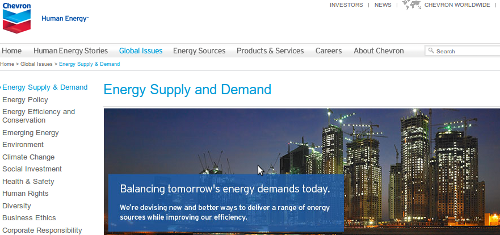
Image Credit: Chevron
The petroleum industry now wrestles with a future fraught with the threat of global climate change, industrial disasters and resource depletion, even as technological innovation also promises to open up new areas for resource extraction and create greater fuel efficiency. Chevron's website speaks to many of the issues the future brings when it comes to the petroleum industry: Energy Supply and Demand, Energy Policy, Energy Efficiency and Conservation, Emerging Energy, Environment, Climate Change, and others. The first Chevron image above acknowledges the consumer desire to "use less energy" and it promises that Chevron too will help governments and businesses to become more energy efficient. The ad does not explicitly state that people wish to use less energy to save money (let alone consider the idea that oil reserves will one day run out), and the ad uses a positive, can-do tone. Yet, the ad cannot avoid responding to troubles on the horizon.
A second Chevron image from its Supply and Demand web page acknowledges greater energy demands in the future, showing a picture of skyscrapers under construction that look much more like the buildings of today than the futurism of Bel Geddes in the Shell ads from 1937, reigning in optimism for a more realist and incremental outlook.
The kairos of the two eras influences the choices made by the ad creators—Art Deco's optimism vs. the pessimism of our millennial age. Below in a 2007 ad, Shell promises, "We invest today's profits in tomorrow's solutions," elaborating that "The challenge of the 21st century is to meet the growing need for energy in ways that are not only profitable but sustainable."
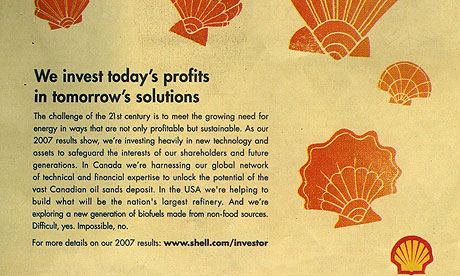
Image Credit: Shell
Even this nod to a potentially difficult future is couched in hopeful language befitting an ad promoting a company. Shell speaks of "tomorrow's solutions" and "challenges" not problems, though those problems lurk beneath the surface. Unlike the Shell of 1937 that looks to the forecasts of Bel Geddes futurism, the Shell of 2007 century takes on the task of describing and shaping the future. And, their future promises not utopian transformation but a kind of stasis, holding onto energy production that is at once sustainable, profitable, and able to meet the "growing need for energy." Another 70 years, and likely considerably less time, will tell whether such a prediction is any less utopian than a smooth rush hour commute.
The opinions expressed herein are solely those of viz. blog, and are not the product of the Harry Ransom Center.






Recent comments
2 years 29 weeks ago
2 years 44 weeks ago
2 years 44 weeks ago
2 years 50 weeks ago
3 years 4 weeks ago
3 years 4 weeks ago
3 years 4 weeks ago
3 years 6 weeks ago
3 years 6 weeks ago
3 years 6 weeks ago